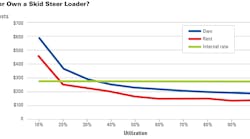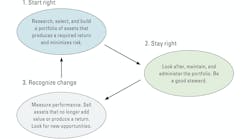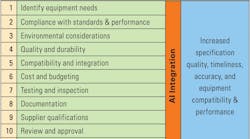Many folk accuse me of spending too much time on trick plays and forgetting the basics of the business. Trick plays are fun, but they only work if your blocking and tackling are excellent; you have to know the basics.
Let’s look at three things you have to have to attack the causes of cost and three things you need to do to ensure the attack is successful. They are important when times are good; they are critical when times are bad.
Attack equipment costs
1) Operators. Skill, knowledge and ability are critical. Many leading organizations are achieving excellent results by using one of the new-generation simulators to enhance skills and identify bad habits. Impartial, quantitative simulator performance results can and should be combined with observations from the field to identify excellence and show operators that there is more to their job than simply grinding out another day behind the controls.
Great organizations understand that skill and ability are not enough. They improve performance by focusing on ownership of the machine and pride in the workplace. To stick to basics: Machines with dedicated operators perform better than machines operated by the first qualified or semi-qualified person that comes along. Reliability and uptime are noticeably higher, and costs are noticeably lower. It is not easy, but discipline and common sense regarding “who is in the seat today” pay huge dividends.
Pride in the workplace is also basic common sense, primarily cleanliness and safety in the cab. Broken windows, hamburger wrappers from the last month, gauges and switches that don’t work, and a mess on the floor are all signs that no one cares. A messed up cab is the sign of a messed up machine and a “who cares” attitude at all levels. Tidy the cabs, take pride, and give operators a good workplace.
2) Mechanics. There is no way for a mechanic to fake knowledge and ability. There are, however, lots of ways for them to end up with obsolete knowledge about obsolete machines. The amount of electronics in a machine doubles every five years. If you do not have the opportunity, attitude and aptitude to keep up, you will fall behind and join the walking dead.
Again, it is not complicated: We absolutely must ensure that our mechanics have technical skills that match or exceed the technology in the machines they look after. This is particularly true when it comes to diagnostics and trouble shooting. The tools that enable us to find the root cause and fix a problem once and for all are available. The question is, do we have them and do we know how to use them.
As with operators, the human side of our enterprise is at least as important as the technical side. Are your mechanics overworked, over-rushed and underappreciated? Do they have the tools, facilities and time—both in the shop and in the field—to do the quality work we expect? Can they stay ahead of the work-load curve and take pride in what they do, or is every minute spent fighting fires?
Two facts cannot be denied. First, repairs done before failure are cheaper and quicker than repairs after failure. Second, no repair is complete until the cause has been identified and eliminated. Staying ahead of the curve and working to prevent the next failure is basic blocking and tackling. Constantly playing catch-up is living on the edge of disaster.
3) Facilities. Many of us speak about the shortage of facilities: the shortage of bays, mechanics trucks, or tools and equipment. Shortage can most certainly be a problem, but perhaps the problem is much more basic: How well do we look after, tidy and keep clean the space that we have? It is essential for safety, improves efficiency; there is no way you can do quality work when the shop looks like a pigsty. It is not rocket science, but it does take discipline. To help, go through the classic 5S methodology, from “The Toyota Way,” by Jeffrey K. Liker:
- Sorting: Keep essential items in easily accessible places. Eliminate the rest; don’t collect clutter.
- Straightening: There should be a place for everything, and everything should be in its place.
- Systematic cleaning: At the end of each day, clean the work area and make sure that everything is ready for the next shift.
- Standardization: Keep things simple, keep things the same, make sure everybody knows where things are.
- Sustaining: Once you have things sorted, straightened, cleaned and standardized, keep it that way; do not slide back into bad habits.
Race car shops are as clean and neat as they are for a good reason. Work has to be done right the first time; sloppy work, dirty work and less than 100-percent attention to detail just does not cut it.
Maintain control of equipment costs
Now let’s discuss three basic, simple, common-sense things that make our attack successful.
1) Fluids. Machines use a large quantity of fuel, oil, coolant and air. One or more of these fluids is needed in almost every part of the machine, and if we permit them, they will carry dirt into every corner of every mechanical system. It therefore makes sense to be fanatical when it comes to cleanliness in the fluids used by your machine.
The supply lines are long. Except for air, we store and re-handle fluids a number of times before they end up where they should be. Every transfer is an opportunity to add a little unwanted dirt. Nothing is achieved if we buy clean fuel, store it in tanks without descant filters, take it to the job in dirty trucks, and dispense it through hoses and nozzles recently wiped clean with oily and dusty rags. The same is true with lubricants. It is no good buying the best if we add a little of nature’s best in the form of dirt while storing it and dispensing it or every time we pull a dip stick or open a tank to check a level.
Dirt and dust mixed with fuel, oil, coolant and air is nothing more than grinding paste waiting to go to work. Keeping your fluids clean all the way from procurement to final end use is a fundamental necessity. You can’t take short cuts, and you can’t fix the damage once the grinding paste has gone to work.
2) Diagnostics. Sometimes wear and tear is easy to feel, touch and see. We can see a ripper tip or cutting edge wearing down, and it is inexcusable to let this go to a stage where the machine is damaged or production is lost. Most times, deterioration is inside an engine, transmission or other mechanical compartment, and we cannot readily see signs of impending failure. This is when diagnostics comes in, and when we must develop the skills needed to “hear what the machine is telling us.”
Diagnostic tools vary from routine, disciplined inspection programs all the way to sophisticated vibration- and temperature-sensing technologies that detect impending failure. Oil analysis is a perfect example of a tool that has proven its value. A successful and effective oil-analysis program is a back-to-basics requirement. Successful programs don’t just say, “Take samples, have them analyzed, and look at the results.” Successful programs include the procedures, metrics and action steps needed to manage the sampling process and ensure that the required compartments are sampled at the required times. They also include the procedures, metrics and action steps needed to ensure that recommendations lead to timely action and appropriate corrective measures.
Quantification is essential for effective communication. A disciplined inspection program that produces written reports and photographs of visible deterioration and an effective oil-analysis program that presents data regarding deterioration in the principal mechanical components provide the indisputable facts needed to drive preemptive action and simultaneously improve reliability and cost. There is nothing fancy, nothing untried, and nothing untested. It is a basic necessity to do it and to do it well.
3) Preventive and condition-based maintenance. There are three different kinds of work order. First is red work orders, initiated by the machine because it has broken down and needs to be repaired. Second, blue work orders are initiated by your preventive maintenance system because a certain period of time has elapsed and predefined work to check, change or adjust something is necessary. Third, green work orders are written by your condition-based maintenance system because you have diagnosed a pending problem and are working to prevent failures rather than fight fires.
Red work orders are expensive and disruptive. Good organizations have metrics that measure them and minimize their occurrence. Blue work orders are a necessary first line of defense against red work orders. Green work orders are investments in future reliability: Great organizations use them to reduce the incidence of red work orders to all but zero.
Measuring and managing red, blue and green work orders is basic blocking and tackling when it comes to focusing your efforts, reducing cost, and improving performance. If you do it, you will know that your efforts regarding skilled operators, excellent mechanics, great facilities, clean fluids, and effective diagnostics are working. If you do not do it, you will be flying in the dark—not a nice place to be.




